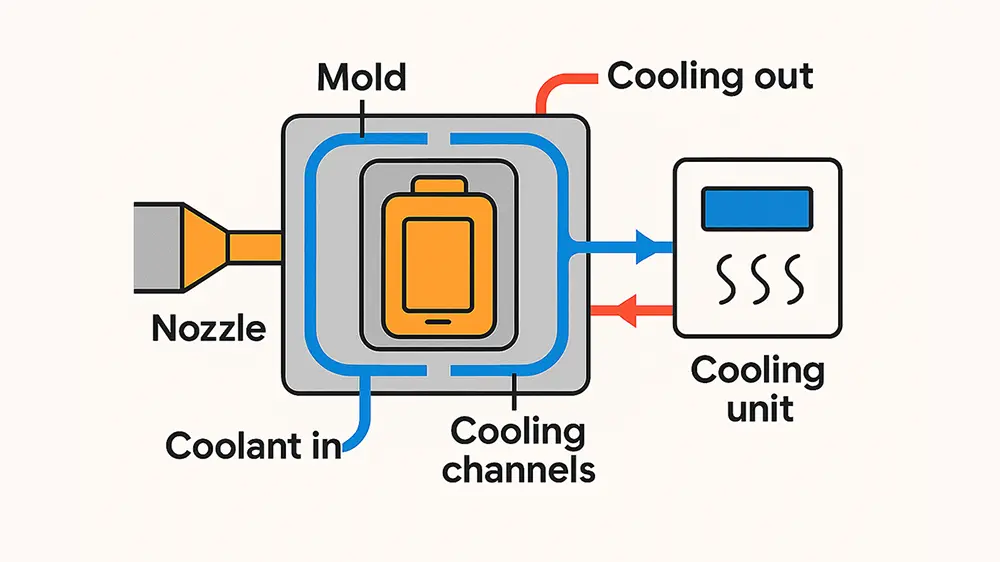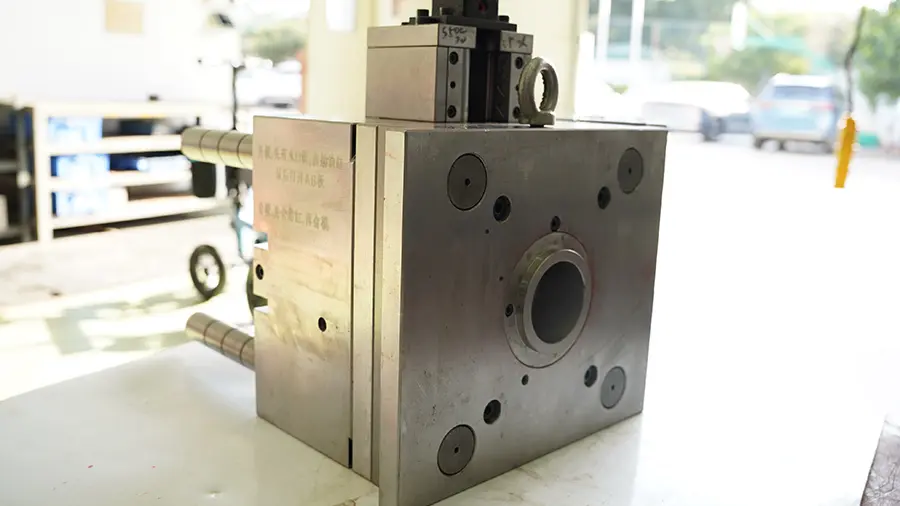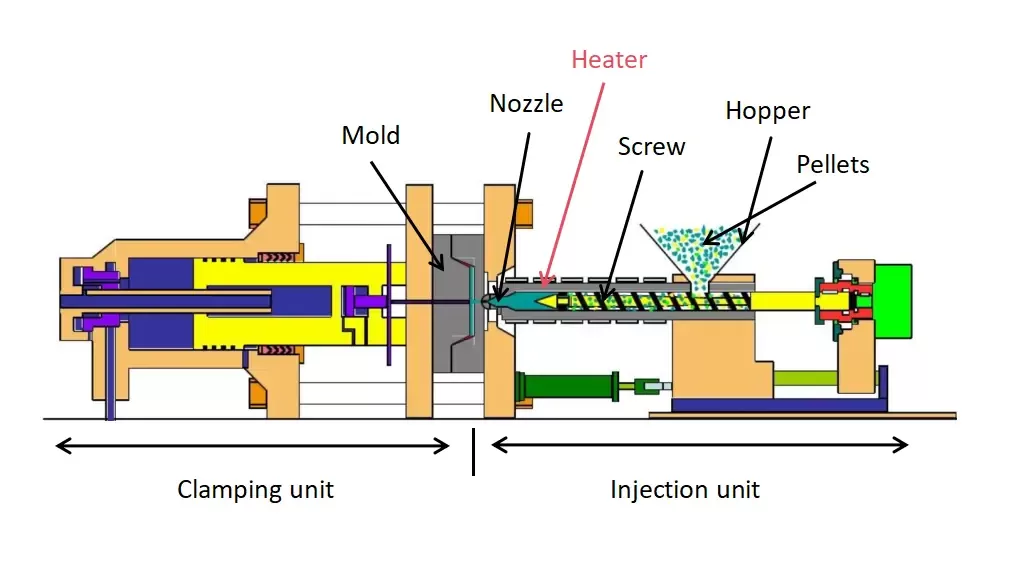Plastic material is one of the most commonly used materials for daily necessities. As an important means of production, injection molding is one of the most important factors affecting plastic products. The technological parameters of the molding process directly determine the flow state of the melt in the mold cavity, which has the most direct and far-reaching influence on the quality of the products. Therefore, it is an effective way to improve the quality of plastic products to find the optimal technological conditions for the molding of the products and control the molding process. Here we will introduce the influence of the injection molding process on product performance.
- Injection pressure
Injection pressure refers to the pressure exerted by the top of the screw or the plunger on the plastic melt during the injection process. Its role is to allow the melt to mix and plasticize, the screw (or plunger) must provide resistance to overcome the flow of solid particles and melt in the cylinder and nozzle. It makes the plastic melt fill the mold cavity at a certain speed, and compacts the mold cavity after it is filled with the melt, making the plastic part dense and filling the shrinkage caused by the cooling of the melt, so as to keep the plastic part inaccurate shape. The injection pressure is mainly determined by the type of plastic, the type of injection molding machine, the temperature of the mold, the mold structure, and the wall thickness of the plastic parts, among which the size and structure of the casting system have a great influence on the injection pressure.
- Injection time
Injection time is one of the parameters controlling the injection rate. The shorter the injection time, the higher the injection rate. The size of the injection rate has a great influence on the performance of the plastic parts. Increasing the injection rate can increase the filling pressure, which is beneficial to the filling process, and reduce the heat loss in the filling process. At the same time, it can reduce the shrinkage of products, reduce the core orientation of plastic parts and increase the strength of fusion joints. The improvement of injection rate is beneficial to the comprehensive performance of products, but too high an injection rate will increase pressure loss, reduce the thickness of the curing layer, improve the surface orientation of plastic parts, and even make the melt elastic turbulence, make plastic parts easy to form flash, surface crack, etc. The experiment proved that too high or too low an injection rate would lead to a decrease of impact strength. The low injection rate makes the weld strength decrease, the general orientation effect increase, and the internal stress increase.
- Retaining Pressure
When the melt fills the cavity, the injection pressure compacts the melt in the mold. In actual production, the holding pressure should be equal to or less than the pressure used for injection. When the holding pressure is equal to the injection pressure, the shrinkage rate of plastic parts is often reduced and the stability and mechanical properties of plastic parts can be guaranteed. In general, the effect of holding pressure on product quality is similar to that of injection pressure. Most of the characteristics of plastic parts and parts of the structure, and to overcome the melt from the barrel to the mold cavity flow resistance, the molten material into the cavity and compaction, often accompanied by the increase in residual stress during demolding, resulting in plastic parts demolding difficulties, deformation, surface scratches, flanges and so on. Therefore, the selection of pressure when the need for careful selection.
- Holding time
Holding time and cooling time also have a direct impact on the quality of plastic parts. Shortening the holding time will reduce the pressure of the mold cavity, which may cause backflow, shrinkage cavity, depression, and other defects, and affect the stability of the size of the plastic parts. Longer holding time can improve the dimensional stability of plastic parts and avoid the occurrence of the above defects. At the same time, it will increase the cavity pressure and change the internal stress caused by uneven temperature. But it will increase the demolding difficulty, easy to produce surface scratches or plastic top bending. The length of plasticizing time can affect the plasticizing quality and directly affect product performance. Time is too short to make the plasticization uniform, consistent temperature, easy to produce hard, silver wire and so on, and too long will make the molten material due to the role of the screw decomposition, burns, and so on, also bring bad effects on product quality.
- Plasticizing pressure
Plasticizing pressure refers to the screw top melting in the screw back when the pressure. Its influence on injection molding is mainly reflected in the plasticizing effect of the injection machine on the material and its plasticizing ability. Generally speaking, increasing the plasticizing pressure, the screw retreat speed decreases, the melt pressure in the barrel increases. As a result, the sheer effect is strengthened and the plasticizing effect is improved. However, it should be noted that, when the back pressure is increased, the excessive plasticizing pressure, on the one hand, reduces the plasticizing amount due to the reverse flow and leakage flow of the melt at the edge of the screw groove, which may cause insufficient measurement; on the other hand, it may cause excessive shear heat and excessive shear stress, which may degrade the material, cause bubbles or burns, and affect the quality of the plastic parts.
- Mold temperature
Mold temperature refers to the temperature of the cavity surface during the molding process. The mold temperature affects the melt filling flow, the product cooling speed, and product performance. The setting of the mold temperature mainly depends on the viscosity of the melt. Low mold temperature injection can be used to shorten the cooling time and improve production efficiency. Melt viscosity should be high-temperature injection molding. Raising the temperature of the mold can make the cooling rate of the workpiece uniform and prevent the forming defects such as indentation and crack. Mold temperature control directly determines the rate of cooling and further determines the rate of crystallization. When the mold temperature is high, the cooling rate is low and the crystallization rate is high. Mold temperature is too high, which will extend the molding cycle and make the product brittle. In the case of low mold temperature and a large cooling rate, the flow of molten material and crystallization occur simultaneously. The residence time of molten material in the crystallization temperature range is shortened, which is not conducive to crystal growth, resulting in a low degree of molecular crystallization of the product and affecting its performance. The mold temperature is too low, the plastic melt flow resistance is very large, the flow rate becomes slow, and even in the filling of the mold solidification hinders the subsequent feeding, making the parts short shot, forced orientation, often cause plastic parts to lack of material, sag, weld defects.
- Barrel temperature
In order to ensure the normal flow of plastic melt and do not make it metamorphic decomposition, it is necessary to choose a suitable cylinder temperature, the average molecular weight is large, the distribution of concentrated plastic and glass-reinforced plastic should choose a higher temperature cylinder temperature. The temperature of the cylinder is generally arranged according to the principle of high before and low after, but when the plastic contains too much water, the temperature of the rear end can be appropriately increased.
- Nozzle temperature
In order to avoid the melt at the nozzle to produce flow delay, need to make the nozzle temperature slightly lower than the maximum temperature of the cylinder. Generally, in the case of low-speed air injection, the efflux is smooth without bubbles, which is considered the appropriate temperature standard.
- Melt temperature
The melt temperature mainly depends on the temperature of the barrel and the nozzle, which affects the plasticization of the material and the injection filling of the melt. The increase of injection temperature is mainly conducive to improving the fluidity of melt, which is related to many characteristics of products. With the increase of melt temperature, the mechanical properties of plastic parts, such as internal stress, impact strength in streamline direction, flexibility, and tensile strength, can be reduced, while the impact strength, flow length, and surface roughness perpendicular to streamline direction can be improved, and the POST-SHRINKAGE of products can be reduced.
Increasing melt temperature is conducive to improving the filling condition and the transfer in the die cavity, reducing the orientation and so on, and improving the comprehensive properties of plastic products. But a too high a temperature is not feasible, because when they melt temperature is close to the upper limit of the injection temperature range, it is easy to produce more gas, which makes the plastic parts produce bubbles, voids, discoloration, burning, flying edges, etc. On the other hand, it will degrade the plastic, reduce the strength of the plastic parts and lose elasticity.
- Special Process Impact
Under high vibration pressure, with the increase of vibration frequency, the tensile properties and notched impact strength of plastic products are obviously improved. In addition, the addition of ultrasonic technology can also play a good role.
The injection molding process plays an important role in the quality of products. In the process of molding, the defects of molding machinery, die design and material properties can sometimes be remedied by appropriate molding process settings. In a word, the processing conditions of injection molding have an important impact on the appearance and mechanical properties of plastic products. Each process parameter is not independent of the other, and some defects of products are the result of the interaction.





